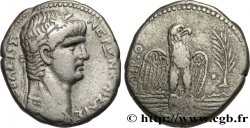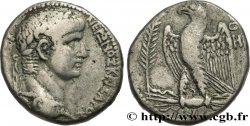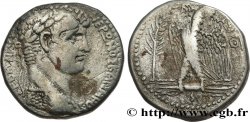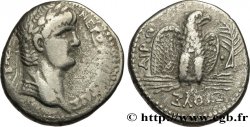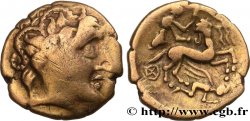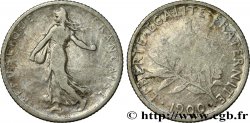bpv_297328 - NERO Tétradrachme syro-phénicien
Not available.
Item sold on our e-shop (2014)
Price : 190.00 €
Item sold on our e-shop (2014)
Price : 190.00 €
Type : Tétradrachme syro-phénicien
Date: an 10 / 112
Mint name / Town : Antioche, Syrie, Séleucie et Piérie
Metal : silver
Diameter : 24 mm
Orientation dies : 12 h.
Weight : 14,52 g.
Coments on the condition:
Flan un peu étroit
Catalogue references :
Predigree :
Cet exemplaire, qui provient de la trouvaille dite de Banias, est le 0089A_072
Obverse
Obverse description : Buste lauré de Néron à droite avec l'égide sur le cou (O*4) et la coiffure adulte.
Obverse legend : NERWN KAISAR - SEBASTOS, (Nerwn Kaisar SebastoV)
Obverse translation : (Néron césar auguste).
Reverse
Reverse description : Aigle debout à droite sur un foudre ailé, les ailes déployées ; dans le champ à droite, une palme verticale.
Reverse legend : ETOUS / BIR.I
Reverse translation : An 112 de l’ère césarienne - An 10 du règne.
Commentary
L’examen des émissions successives de Néron à Antioche étonne car chaque séquence de frappe se caractérise par un style et un graveur différent : tout se passe comme si la gravure des coins de droit faisait l’objet d’une mise aux enchères et de l’attribution d’un marché, un seul graveur réalisant tous les coins de droit de l’année. Il est d’ailleurs assez facile de dater ces monnaies en regardant simplement le portrait, sans retourner la pièce ni donc lire la date qui s’y trouve.
Certes, nous n’avons pas d’informations sur l’organisation de l’atelier d’Antioche mais il est plausible, au vu de la grande qualité de certains des graveurs, qu’il s’agissait d’artisans et non d’esclaves ; par ailleurs, la personnalisation des représentations impériales, la faculté, bien mieux qu’à Rome, d’y laisser transparaître leur personnalité jusqu’à la limite du pamphlet politique, laisse penser que l’école hellénistique et non romaine formait les graveurs d’Antioche.
Comme il n’est de règle qui n’ait d’exception, nous avons du séparer en deux, comme les auteurs du RPC l’avaient déjà fait, les frappes de l’an 112 ; en effet, il a fallu créer le Prieur 89A pour accueillir un graveur différent, plus proche de celui qui réalisera les Prieur 90.
L’émission normale est importante et dans la base TSP maintenue par Michel Prieur, cent quatre-vingt deux exemplaires sont maintenant répertoriés.
The examination of the successive issues of Nero in Antioch is surprising because each striking sequence is characterized by a different style and a different engraver: everything happens as if the engraving of the obverse dies was the subject of an auction and the allocation of a contract, with a single engraver producing all the obverse dies of the year.. It is also quite easy to date these coins by simply looking at the portrait, without turning the coin over or reading the date on it..
Certainly, we have no information on the organization of the Antioch workshop but it is plausible, given the high quality of some of the engravers, that they were artisans and not slaves; moreover, the personalization of the imperial representations, the ability, much better than in Rome, to let their personality shine through to the limit of the political pamphlet, suggests that the Hellenistic school and not the Roman school trained the engravers of Antioch.
As there is no rule without an exception, we had to separate the strikes of the year 112 into two, as the authors of the RPC had already done; in fact, it was necessary to create the Prieur 89A to accommodate a different engraver, closer to the one who would produce the Prieur 90.
The normal issue is important and in the TSP database maintained by Michel Prieur, one hundred and eighty-two examples are now listed
Certes, nous n’avons pas d’informations sur l’organisation de l’atelier d’Antioche mais il est plausible, au vu de la grande qualité de certains des graveurs, qu’il s’agissait d’artisans et non d’esclaves ; par ailleurs, la personnalisation des représentations impériales, la faculté, bien mieux qu’à Rome, d’y laisser transparaître leur personnalité jusqu’à la limite du pamphlet politique, laisse penser que l’école hellénistique et non romaine formait les graveurs d’Antioche.
Comme il n’est de règle qui n’ait d’exception, nous avons du séparer en deux, comme les auteurs du RPC l’avaient déjà fait, les frappes de l’an 112 ; en effet, il a fallu créer le Prieur 89A pour accueillir un graveur différent, plus proche de celui qui réalisera les Prieur 90.
L’émission normale est importante et dans la base TSP maintenue par Michel Prieur, cent quatre-vingt deux exemplaires sont maintenant répertoriés.
The examination of the successive issues of Nero in Antioch is surprising because each striking sequence is characterized by a different style and a different engraver: everything happens as if the engraving of the obverse dies was the subject of an auction and the allocation of a contract, with a single engraver producing all the obverse dies of the year.. It is also quite easy to date these coins by simply looking at the portrait, without turning the coin over or reading the date on it..
Certainly, we have no information on the organization of the Antioch workshop but it is plausible, given the high quality of some of the engravers, that they were artisans and not slaves; moreover, the personalization of the imperial representations, the ability, much better than in Rome, to let their personality shine through to the limit of the political pamphlet, suggests that the Hellenistic school and not the Roman school trained the engravers of Antioch.
As there is no rule without an exception, we had to separate the strikes of the year 112 into two, as the authors of the RPC had already done; in fact, it was necessary to create the Prieur 89A to accommodate a different engraver, closer to the one who would produce the Prieur 90.
The normal issue is important and in the TSP database maintained by Michel Prieur, one hundred and eighty-two examples are now listed







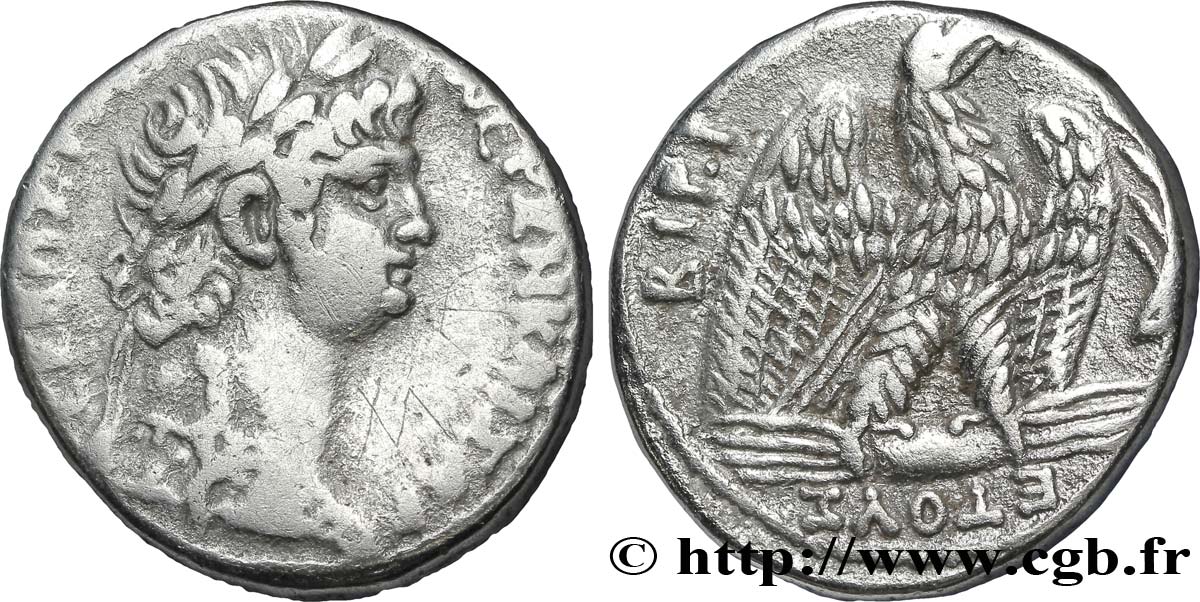
 Report a mistake
Report a mistake Print the page
Print the page Share my selection
Share my selection Ask a question
Ask a question Consign / sell
Consign / sell
 Full data
Full data